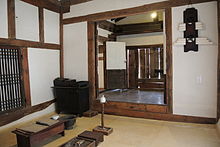| Sarangchae | |
 | |
| Korean name | |
|---|---|
| Hangul | 사랑채 |
| Hanja | 舍廊채 |
| Revised Romanization | Sarangchae |
| McCune–Reischauer | Sarangch'ae |
| sarangbang | |
| Hangul | 사랑방 |
| Hanja | 舍廊房 |
| Revised Romanization | sarangbang |
| McCune–Reischauer | sarangbang |
A sarangchae (Korean: 사랑채) is a section of a Korean traditional house (hanok) that is generally reserved for men and guests. It can be composed of a number of rooms and elements, including notably the sarangbang (사랑방). In smaller homes, the sarangchae may just consist of a single sarangbang, in which case they are one and the same.
The anchae and anbang are the female-oriented counterparts. They are more private sections of the house exclusive to women (and prohibited to especially male guests), from which they cook, store precious items away from guests, and manage the household.[1]
These gendered spaces first emerged around the Joseon period, following a Confucian ideal of strict separation of genders. They became widespread during that period, even in the countryside.[1] However, they are now uncommon.
- ^ a b "사랑(舍廊)". Encyclopedia of Korean Culture (in Korean). Retrieved 2023-08-27.